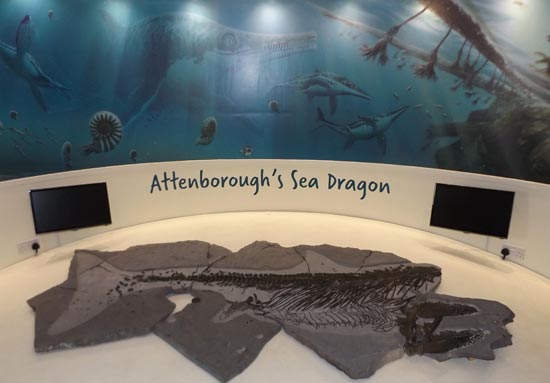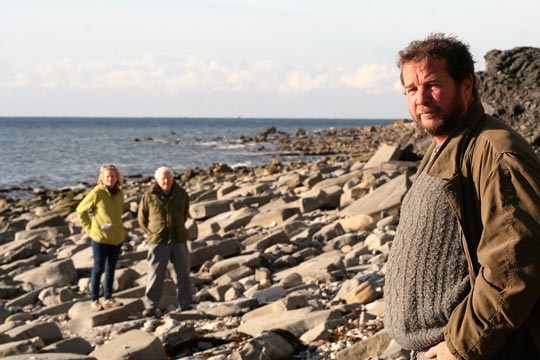“Attenborough’s Sea Dragon” on Display
Ichthyosaur Specimen on Display at Charmouth Heritage Coast Centre
The fossilised remains of a new species of ichthyosaur are on display at the Charmouth Heritage Coast Centre for the rest of this year. The Centre, based on the famous Jurassic coast of Dorset, will be home to the partial skeleton of a four-metre-long, new species of “fish lizard”, it’s discovery and excavation was documented in a BBC television programme shown back in January.
The New Ichthyosaur Display at the Charmouth Heritage Coast Centre

Picture credit: Charmouth Heritage Coast Centre
The Tale of a Sea Dragon
Narrated by Sir David Attenborough, the programme told the story of the fossil’s discovery by experienced local collector Chris Moore. Chris along with a team of climbing experts and geologists spent weeks excavating the rock containing the creature by hand from a Dorset cliff. The headless skeleton, that even retained evidence of ichthyosaur skin, was transported by boat back to Lyme Regis so that the matrix covering the bones could slowly be removed and full details of the 200-million-year-old specimen revealed.
To read Everything Dinosaur’s article about the BBC documentary: Attenborough and the Sea Dragon.
Experts from Southampton and Bristol Universities studied and analysed the skeleton as well as the exceptionally well-preserved skin still on the bones. They identified it as a new species of ichthyosaur, probably an animal of the open ocean that for some reason had come closer to the shore, where, in the coastal waters, it was attacked and killed by a much larger animal. The palaeontologists, preparators and researchers had a murder scene on their hands. In the television programme, a CGI version of the unfortunate marine reptile was created and its final moments re-enacted, an attack by a super predator, one of the most dangerous animals on the planet during the Early Jurassic – a ferocious Temnodontosaurus.
Everything Dinosaur’s Illustration of Temnodontosaurus

Picture credit: Everything Dinosaur
For models and replicas of ichthyosaurs and other marine reptiles: CollectA Prehistoric Life Models.
Attacked by a Much Larger Ichthyosaur
As the fossilised skeleton was slowly but surely revealed, damaged vertebrae and broken ribs provided evidence of an attack by a much bigger marine reptile. The assailant was probably a Temnodontosaurus, one of the largest of the Ichthyosauria, capable of growing to around ten metres in length with a body mass estimated at approximately two tonnes. The attacker did not get its prize, the researchers speculated that the initial bite on the unfortunate victim, punctured the animal’s body cavity releasing air from the lungs and the ichthyosaur’s body descended into the deep.
The body of the ichthyosaur descended rapidly and it was soon out of the diving range of the attacker, coming to rest on the seabed. The corpse was rapidly covered by fine sediment and fossilisation eventually took place, two hundred million years later, fossil hunter Chris Moore spotted part of the skeleton eroding out of a cliff and the process of excavating the specimen was begun.
Chris Moore (Foreground) with Sir David Attenborough and Sally Thompson (Producer/Director of the Television Documentary)

Picture credit: Charmouth Heritage Coast Centre
Sea Dragon Tale Narrated by Sir David Attenborough
Veteran naturalist, life-long fossil collector and highly esteemed broadcaster, Sir David Attenborough explained in the hour-long programme:
“It’s been a fascinating journey of discovery, but for me the real wonder is the bones themselves. It is a long time spent just revealing the body of this creature, but it’s also revealed this extraordinary story of life and death, predator and prey fighting it out in the seas 200 million years ago, just down there (at the beach).”
Team members from Everything Dinosaur are hoping to visit the exhibit at the Charmouth Heritage Coast Centre when they will be working on the Dorset coast in the autumn.
As the BBC television programme drew to a close, Sir David Attenborough remarked:
“For Chris [Chris Moore], this has been a labour of love and its filled in another gap in the palaeontological jigsaw. A story that all started with an odd-looking boulder on a Dorset beach. It’s extraordinary to think that some 200 million years ago exactly here, the greatest predator of its time was swimming around in the sea, and that’s what I love about fossils and fossil hunting, it gives you an extraordinarily vivid insight into what the world was like millions of years before human beings even appeared on this planet.”
Attenborough’s Sea Dragon is on display at Charmouth Heritage Coast Centre throughout 2018.
For further information on the Charmouth Heritage Coast Centre: Charmouth Heritage Coast Centre.
Visit the award-winning Everything Dinosaur website: Everything Dinosaur.

